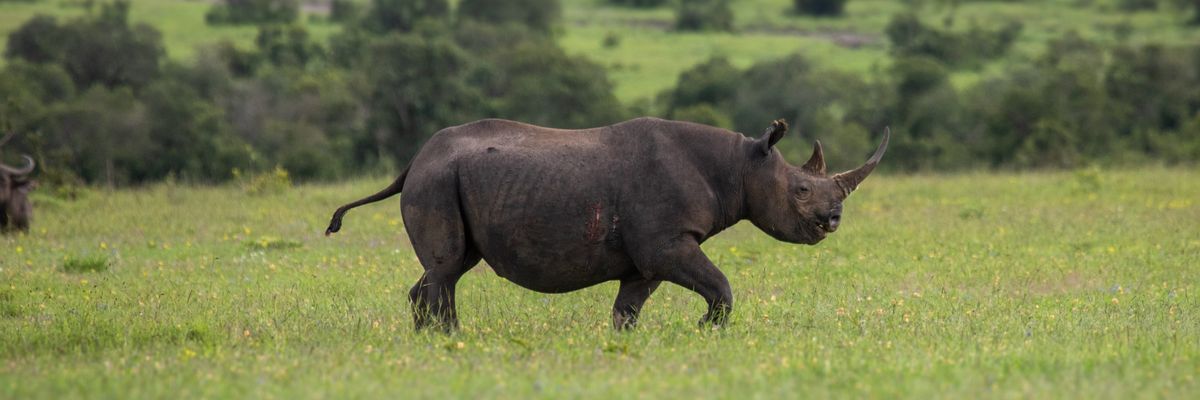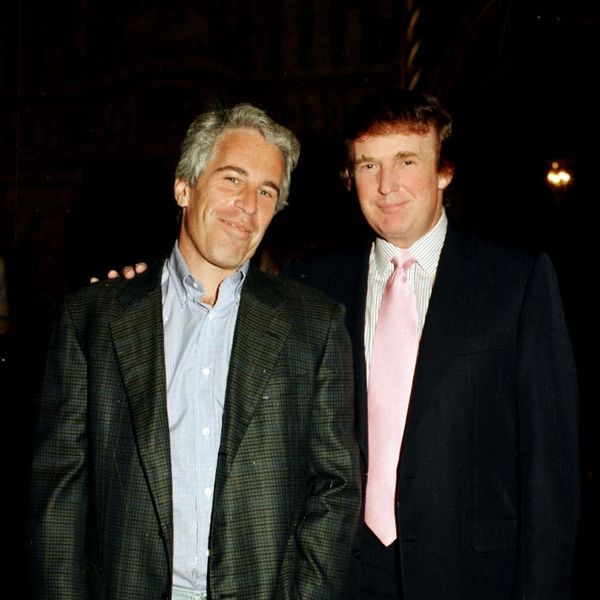
A black rhino walks through Samburu National Reserve in Kenya on November 22, 2023.
Conserving Just 1.2% of Earth's Land Could Save Most Threatened Species From Extinction
More than a third of the sites identified as most vulnerable lie within a mile and a half of lands that are already protected, making the task entirely "doable," said one scientist.
Researchers revealed in a study published Monday that world governments are not doing enough to save the most endangered plant and animal species from extinction, and called for a more targeted approach to protect biodiversity.
Eric Dinerstein, a senior biodiversity expert at Resolve, led a team of researchers in the analysis, which was published in Frontiers in Science and revealed that conserving just 1.2% of the Earth's surface would avert the extinction of the most threatened species on the planet.
The scientists set out to identify the rarest species in the world in limited habitats, with Dinerstein noting that the majority of species are rare.
Most species "either have very narrow ranges or they occur at very low densities or both," he told The Guardian, suggesting that setting aside large percentages of the Earth's land isn't needed to protect the most threatened animals.
For example, the World Wildlife Fund identifies the Javan rhino as the most endangered species on Earth, having suffered "a staggering decline in their numbers due to hunting and habitat loss." Javan rhinos are found only on the island of Java, Indonesia.
Similarly, the Amur leopard has been critically endangered since 1996 and is only found in "a relatively small region of the far east of Russia and northeastern China at present."
"It's almost as if countries are using a reverse-selection algorithm and picking the non-rare sites to add to the global areas under protection. The call to arms of this paper is that we have to be doing a much better job in the next five years."
The study identified 16,825 sites around the world that should be prioritized for conservation over the next five years in order to prevent the extinction of animals and plants that are found only in those places.
Dinerstein told The Guardian that protecting the most vulnerable places is entirely "doable," especially considering 38% of the identified sites are within one and a half miles of areas that are already protected.
More than half the sites are in the Philippines, Brazil, Indonesia, Madagascar, and Colombia.
"Only 7% of the new protected areas between 2018 and 2023 overlapped with the conservation imperative sites," Dinerstein warned, calling for a more targeted approach. "It's almost as if countries are using a reverse-selection algorithm and picking the non-rare sites to add to the global areas under protection. The call to arms of this paper is that we have to be doing a much better job in the next five years."
The United Nations Environment Program reported in 2021 that 16.6% of the world's land surface and waters are currently protected.
Through land purchases, the creation of protected areas on federal lands, the leasing of community reserves and forests, and the expansion of Indigenous rights and land sovereignty, the study says, all of the key sites identified by researchers could be protected over the next five years for roughly $29 billion to $46 billion.
An Urgent Message From Our Co-Founder
Dear Common Dreams reader, The U.S. is on a fast track to authoritarianism like nothing I've ever seen. Meanwhile, corporate news outlets are utterly capitulating to Trump, twisting their coverage to avoid drawing his ire while lining up to stuff cash in his pockets. That's why I believe that Common Dreams is doing the best and most consequential reporting that we've ever done. Our small but mighty team is a progressive reporting powerhouse, covering the news every day that the corporate media never will. Our mission has always been simple: To inform. To inspire. And to ignite change for the common good. Now here's the key piece that I want all our readers to understand: None of this would be possible without your financial support. That's not just some fundraising cliche. It's the absolute and literal truth. We don't accept corporate advertising and never will. We don't have a paywall because we don't think people should be blocked from critical news based on their ability to pay. Everything we do is funded by the donations of readers like you. Will you donate now to help power the nonprofit, independent reporting of Common Dreams? Thank you for being a vital member of our community. Together, we can keep independent journalism alive when it’s needed most. - Craig Brown, Co-founder |
Researchers revealed in a study published Monday that world governments are not doing enough to save the most endangered plant and animal species from extinction, and called for a more targeted approach to protect biodiversity.
Eric Dinerstein, a senior biodiversity expert at Resolve, led a team of researchers in the analysis, which was published in Frontiers in Science and revealed that conserving just 1.2% of the Earth's surface would avert the extinction of the most threatened species on the planet.
The scientists set out to identify the rarest species in the world in limited habitats, with Dinerstein noting that the majority of species are rare.
Most species "either have very narrow ranges or they occur at very low densities or both," he told The Guardian, suggesting that setting aside large percentages of the Earth's land isn't needed to protect the most threatened animals.
For example, the World Wildlife Fund identifies the Javan rhino as the most endangered species on Earth, having suffered "a staggering decline in their numbers due to hunting and habitat loss." Javan rhinos are found only on the island of Java, Indonesia.
Similarly, the Amur leopard has been critically endangered since 1996 and is only found in "a relatively small region of the far east of Russia and northeastern China at present."
"It's almost as if countries are using a reverse-selection algorithm and picking the non-rare sites to add to the global areas under protection. The call to arms of this paper is that we have to be doing a much better job in the next five years."
The study identified 16,825 sites around the world that should be prioritized for conservation over the next five years in order to prevent the extinction of animals and plants that are found only in those places.
Dinerstein told The Guardian that protecting the most vulnerable places is entirely "doable," especially considering 38% of the identified sites are within one and a half miles of areas that are already protected.
More than half the sites are in the Philippines, Brazil, Indonesia, Madagascar, and Colombia.
"Only 7% of the new protected areas between 2018 and 2023 overlapped with the conservation imperative sites," Dinerstein warned, calling for a more targeted approach. "It's almost as if countries are using a reverse-selection algorithm and picking the non-rare sites to add to the global areas under protection. The call to arms of this paper is that we have to be doing a much better job in the next five years."
The United Nations Environment Program reported in 2021 that 16.6% of the world's land surface and waters are currently protected.
Through land purchases, the creation of protected areas on federal lands, the leasing of community reserves and forests, and the expansion of Indigenous rights and land sovereignty, the study says, all of the key sites identified by researchers could be protected over the next five years for roughly $29 billion to $46 billion.
- Groups to Sue Feds for Refusing to Protect Wolves in Western US ›
- Monarch Butterflies Population Plummet 90%, Trump Admin Denies Endangered Species Protection ›
- 'Huge Win for Gray Wolves' as US Court Restores Endangered Species Act Protections ›
- Opinion | Only Plants Can Save the People | Common Dreams ›
Researchers revealed in a study published Monday that world governments are not doing enough to save the most endangered plant and animal species from extinction, and called for a more targeted approach to protect biodiversity.
Eric Dinerstein, a senior biodiversity expert at Resolve, led a team of researchers in the analysis, which was published in Frontiers in Science and revealed that conserving just 1.2% of the Earth's surface would avert the extinction of the most threatened species on the planet.
The scientists set out to identify the rarest species in the world in limited habitats, with Dinerstein noting that the majority of species are rare.
Most species "either have very narrow ranges or they occur at very low densities or both," he told The Guardian, suggesting that setting aside large percentages of the Earth's land isn't needed to protect the most threatened animals.
For example, the World Wildlife Fund identifies the Javan rhino as the most endangered species on Earth, having suffered "a staggering decline in their numbers due to hunting and habitat loss." Javan rhinos are found only on the island of Java, Indonesia.
Similarly, the Amur leopard has been critically endangered since 1996 and is only found in "a relatively small region of the far east of Russia and northeastern China at present."
"It's almost as if countries are using a reverse-selection algorithm and picking the non-rare sites to add to the global areas under protection. The call to arms of this paper is that we have to be doing a much better job in the next five years."
The study identified 16,825 sites around the world that should be prioritized for conservation over the next five years in order to prevent the extinction of animals and plants that are found only in those places.
Dinerstein told The Guardian that protecting the most vulnerable places is entirely "doable," especially considering 38% of the identified sites are within one and a half miles of areas that are already protected.
More than half the sites are in the Philippines, Brazil, Indonesia, Madagascar, and Colombia.
"Only 7% of the new protected areas between 2018 and 2023 overlapped with the conservation imperative sites," Dinerstein warned, calling for a more targeted approach. "It's almost as if countries are using a reverse-selection algorithm and picking the non-rare sites to add to the global areas under protection. The call to arms of this paper is that we have to be doing a much better job in the next five years."
The United Nations Environment Program reported in 2021 that 16.6% of the world's land surface and waters are currently protected.
Through land purchases, the creation of protected areas on federal lands, the leasing of community reserves and forests, and the expansion of Indigenous rights and land sovereignty, the study says, all of the key sites identified by researchers could be protected over the next five years for roughly $29 billion to $46 billion.
- Groups to Sue Feds for Refusing to Protect Wolves in Western US ›
- Monarch Butterflies Population Plummet 90%, Trump Admin Denies Endangered Species Protection ›
- 'Huge Win for Gray Wolves' as US Court Restores Endangered Species Act Protections ›
- Opinion | Only Plants Can Save the People | Common Dreams ›

